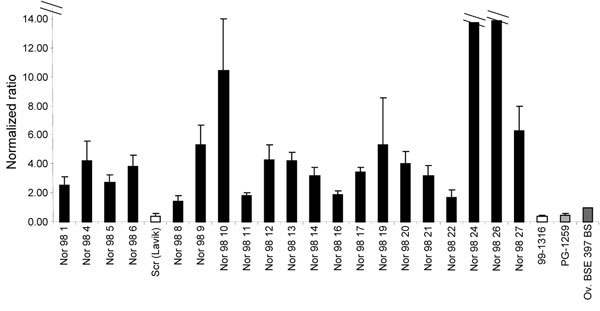Volume 14, Number 4—April 2008
Research
Rapid Typing of Transmissible Spongiform Encephalopathy Strains with Differential ELISA
Appendix Figure 2

Appendix Figure 2. Proteinase K (PK) sensitivity of 21 Norwegian isolates in mild conditions. The ELISA typing test was performed on 20 Nor98 isolates and 1 Norwegian scrapie isolate (Lavik) by using the protective A´´ reagent, with a PK concentration of 1.2 µg/mg tissue. These new conditions (PK 1.2 µg/mg of tissue in A´´ reagent) showed a large range of PK resistance with normalized ratios varying from 1.4 for the most resistant (Lindas isolate), close to the experimental ovine BSE, to >14 for the weakest (Soknedal2). One isolate, Tennevoll, appeared so sensitive to PK digestion that the ratio could not be evaluated (>95) even using these protective conditions.
Page created: July 14, 2010
Page updated: July 14, 2010
Page reviewed: July 14, 2010
The conclusions, findings, and opinions expressed by authors contributing to this journal do not necessarily reflect the official position of the U.S. Department of Health and Human Services, the Public Health Service, the Centers for Disease Control and Prevention, or the authors' affiliated institutions. Use of trade names is for identification only and does not imply endorsement by any of the groups named above.